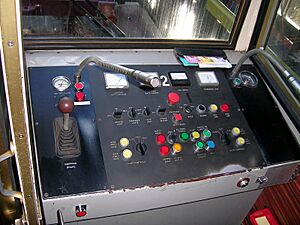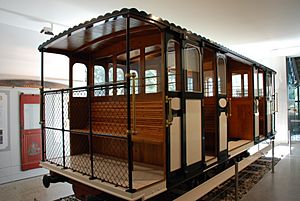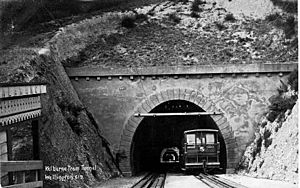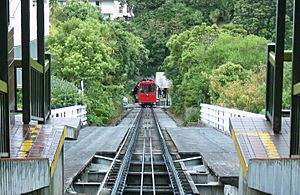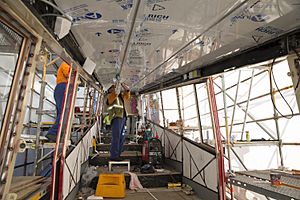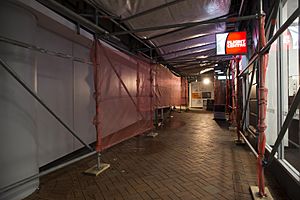Wellington Cable Car facts for kids
Quick facts for kids Wellington Cable Car |
|
|---|---|
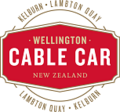 |
|
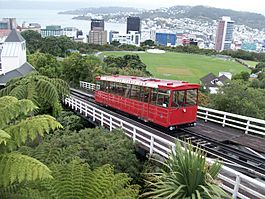
Top view of Wellington Cable Car
|
|
| Overview | |
| Status | in use |
| Owner | Wellington Cable Car Ltd, owned by Wellington City Council |
| Locale | Wellington, New Zealand |
| Service | |
| Type | Funicular |
| Operator(s) | Wellington Cable Car Ltd |
| History | |
| Opened | 1902 |
| Technical | |
| Number of tracks | single track with passing loop in the middle |
| Track gauge | 1,000 mm (3 ft 3 3⁄8 in) |
| Maximum incline | 17.86% |
The Wellington Cable Car is a special type of railway called a funicular. It connects Lambton Quay, a busy shopping street in Wellington, New Zealand, with Kelburn, a suburb high up in the hills. This funicular helps people travel up a steep hill, rising about 120 meters over a track length of 609 meters.
A one-way trip on the Cable Car takes about five minutes. It is a very popular attraction for visitors to Wellington.
Contents
Exploring the Track and Stations
The Cable Car line is mostly straight and is about 628 meters long. It uses a single track with wooden railway sleepers (ties). The only curves on the track are in the middle, where the cars pass each other at Talavera station.
The track goes through three tunnels and over three bridges. Except for the very bottom part, the line goes up at a constant steep angle.
The lower station is in Cable Car Lane, just off Lambton Quay (41°17′03.3″S 174°46′28.7″E / 41.284250°S 174.774639°E). The upper station is right next to the beautiful Wellington Botanic Garden, on Upland Road in Kelburn (41°17′07.25″S 174°46′04.17″E / 41.2853472°S 174.7678250°E).
How the Cars and System Work
The Wellington Cable Car has two cars. They start from opposite ends of the track and meet in the middle. Both cars are connected by a strong cable that goes around a large pulley at the top of the hill. An electric motor at the top powers this pulley, moving the cable.
This system is called a funicular because the cars are permanently attached to the cable. The cable stops and starts with the cars. This is different from a "true" cable car, where the cars grip and release a cable that is always moving.
To help the cars pass each other in the middle at Talavera, some wheels on one side of each car have double edges (flanges). The wheels on the other side have no flanges. This design guides each car to its correct side of the track.
The inside of the cars has steps. This makes the floor flat and comfortable, even though the car is going up a steep hill.
The Cable Car usually travels at about 18 kilometers per hour. Each car can carry around 100 people (30 sitting, 70 standing). An empty car weighs about 13.5 tonnes, and a full car weighs about 21 tonnes.
Who Rides the Cable Car?
Around one million people ride the Cable Car every year. In the mornings and evenings, many people use it to travel between Kelburn and the city for work. During the day, it's popular with tourists visiting the Wellington Botanic Garden. Students going to Victoria University of Wellington also use it.
In December 2023, the Cable Car reached one million passengers in a year again. This was the first time since the COVID-19 pandemic.
Who Owns and Runs It?
The Wellington Cable Car is owned and operated by Wellington Cable Car Ltd. This company is owned by the Wellington City Council. Wellington Cable Car Ltd is in charge of everything. This includes keeping the cars and track in good shape, hiring drivers, selling tickets, and helping customers.
For a while, another company managed the operations. But since 2007, Wellington Cable Car Ltd has managed everything itself. The Cable Car usually makes a profit. However, during the COVID-19 pandemic, fewer people rode it, and it needed financial help from the council. By 2023, it was making a profit again.
The Cable Car Museum
The Cable Car Museum opened in December 2000. It is located in the original building where the winding gear used to be. The museum has two of the first cable cars, Car 1 and Car 3. The old electric winding gear is still there and can be seen working.
Car 1 is painted red, like it was in the 1970s. Car 3 was restored in 2005 to look like it did around 1905, painted green. The museum is run by the Wellington Museums Trust.
A Look at History
Building the First Line
In the late 1800s, Wellington was growing fast. Because the city is very hilly, it was hard to find good places to build houses. When new homes were planned for Kelburn, people suggested building a cable car. This would make it easy to get up the hill.
In 1898, a group of people who were developing the new homes started the Kelburne & Karori Tramway Company. Their idea was to build a tramway between the city and Kelburn. They also planned a road to connect the top station to Karori, a nearby settlement. The city council agreed to the plan, with the condition that they could buy the company later.
The location of Victoria University of Wellington was even influenced by the Cable Car company. The company offered money if the university was built in Kelburn. This meant students would use the Cable Car to get to and from the university.
The engineer who designed the system was James Edward Fulton. He chose the route and decided how it would work. The original system was a mix of a cable car and a funicular. It had a continuous cable that the cars could grip. It also had a balance cable that connected both cars over a pulley at the top. When one car went down, it pulled the other car up.
Construction started in 1899, with teams working day and night. The line opened to the public on 22 February 1902. Many people rode it every day. In 1903, old horse-drawn trams were changed into trailers for the Cable Car, allowing more passengers. By 1912, one million people rode the Cable Car each year. In 1933, the old steam engine was replaced with an electric motor, making it easier to control and cheaper to run.
In the 1940s, the Cable Car faced competition from new city buses. These buses went to the same suburbs, but bypassed the Cable Car. The city council eventually bought the company on 13 February 1947.
By the 1960s and 1970s, people complained that the Cable Car was old and not very comfortable. After an accident in 1973, safety concerns grew. The old wooden cars were considered unsafe, especially when pulling trailers. The trailers were removed, which meant fewer people could ride at once.
The 1978–79 Upgrade
Despite public protests, the Cable Car closed on 22 September 1978 for a big upgrade. New steel cars and equipment were installed by a Swiss company. The line reopened on 22 October 1979, becoming a full funicular system.
At first, the upgraded Cable Car had some issues. The service often stopped for technical reasons and safety checks. Because of these problems, the number of passengers dropped. After a serious accident in 1988, the system had another major update. This fixed most of the problems, and passenger numbers have been growing steadily since then. Every August, a big safety check is done, which takes about a week.
Changes in Management
In 1991, rules about public transport changed. Councils could no longer run transport services directly. The city council sold its bus service but kept the Cable Car. Its operation and maintenance were then handled by private companies.
Over the years, different companies managed the Cable Car. In 1994, the city council decided to do its own maintenance. In 2007, Wellington Cable Car Ltd took over all operations again.
In 1999, cracks were found in a tunnel below Talavera station. These were fixed with metal and reinforced concrete.
In July 2006, the Lambton station was renovated to make it look better and easier to use. New automated ticket gates were added, and the station reopened in December.
2016 Electric System Upgrade
In 2016, the Cable Car had another major upgrade. Its electric drive and control system were replaced. The cars themselves were also given a fresh new look inside.
While the Cable Car was closed for this work, the Wellington City Council also improved the Cable Car Lane and the Lambton Quay Terminal. They replaced the old leaky roof with a new glass one to let in more sunshine. They also built a new ticket booth and moved the entry gates to make buying tickets and queuing easier. New paving and signs were also added to the area.
Fun Facts and Trivia
The famous Kelburn Kiosk was built at the Kelburn terminal in 1905. Sadly, it burned down in 1982. The Skyline Restaurant was built to replace it in 1984.
The first woman to drive a cable car in New Zealand was Lorraine Ruka-Isaac. She drove the Wellington Cable Car from 1979 to 1981.
In March 2022, special stickers were put on the windows of the Kelburn terminal building. These stickers help prevent birds from accidentally flying into the glass. This effort was partly funded by local groups working to protect urban wildlife.
See also
- Trams in New Zealand
- Cable car (railway)
- Funicular
- List of funicular railways
- San Francisco cable car system
- Peak Tram


